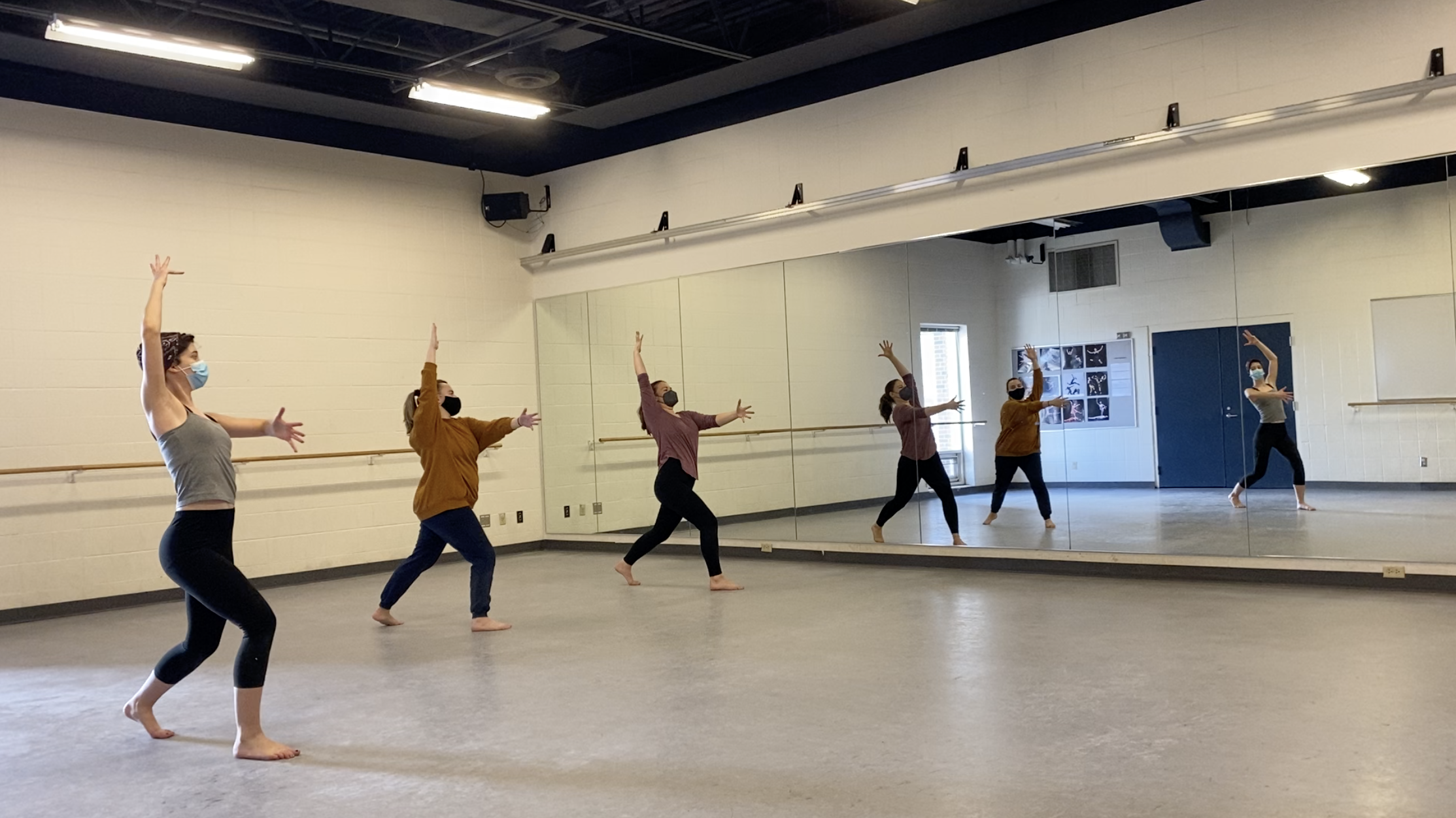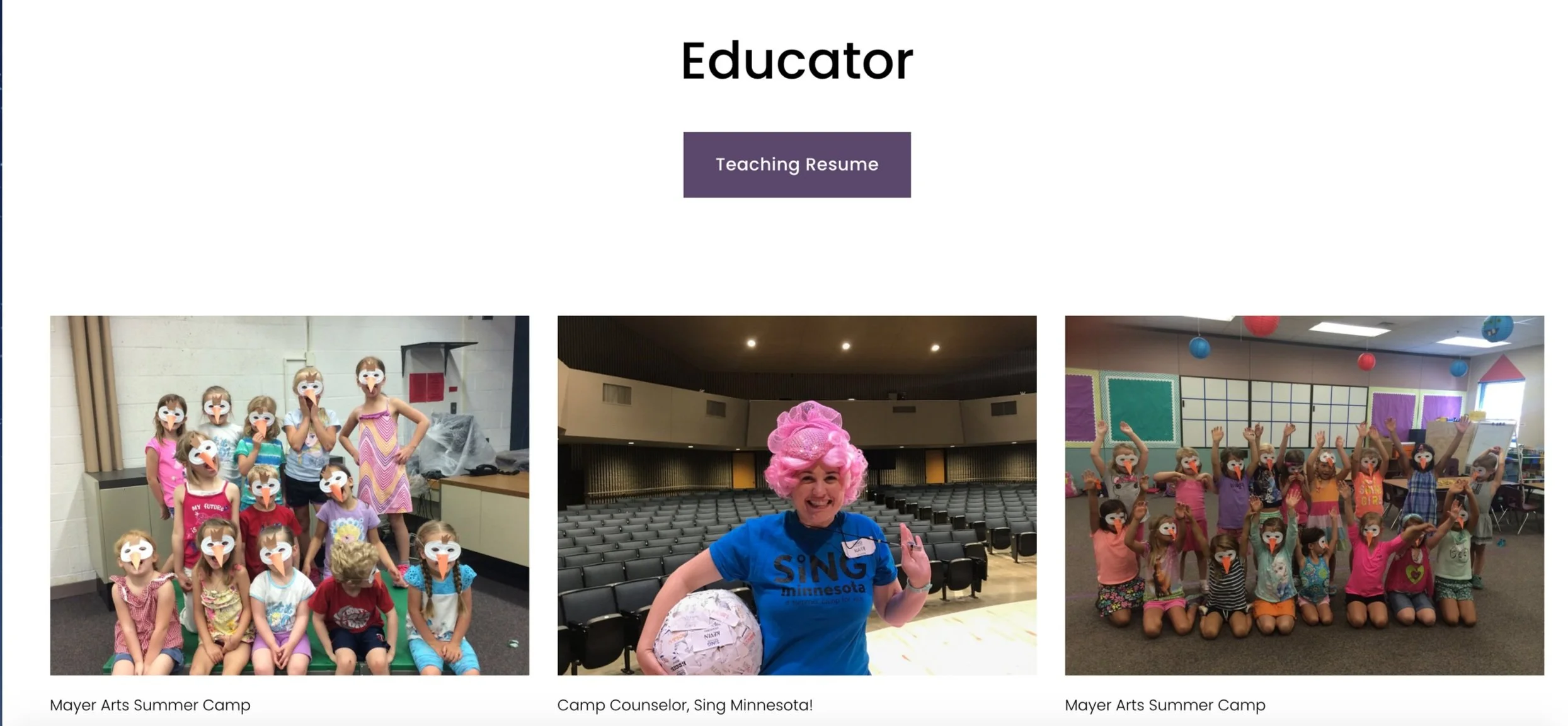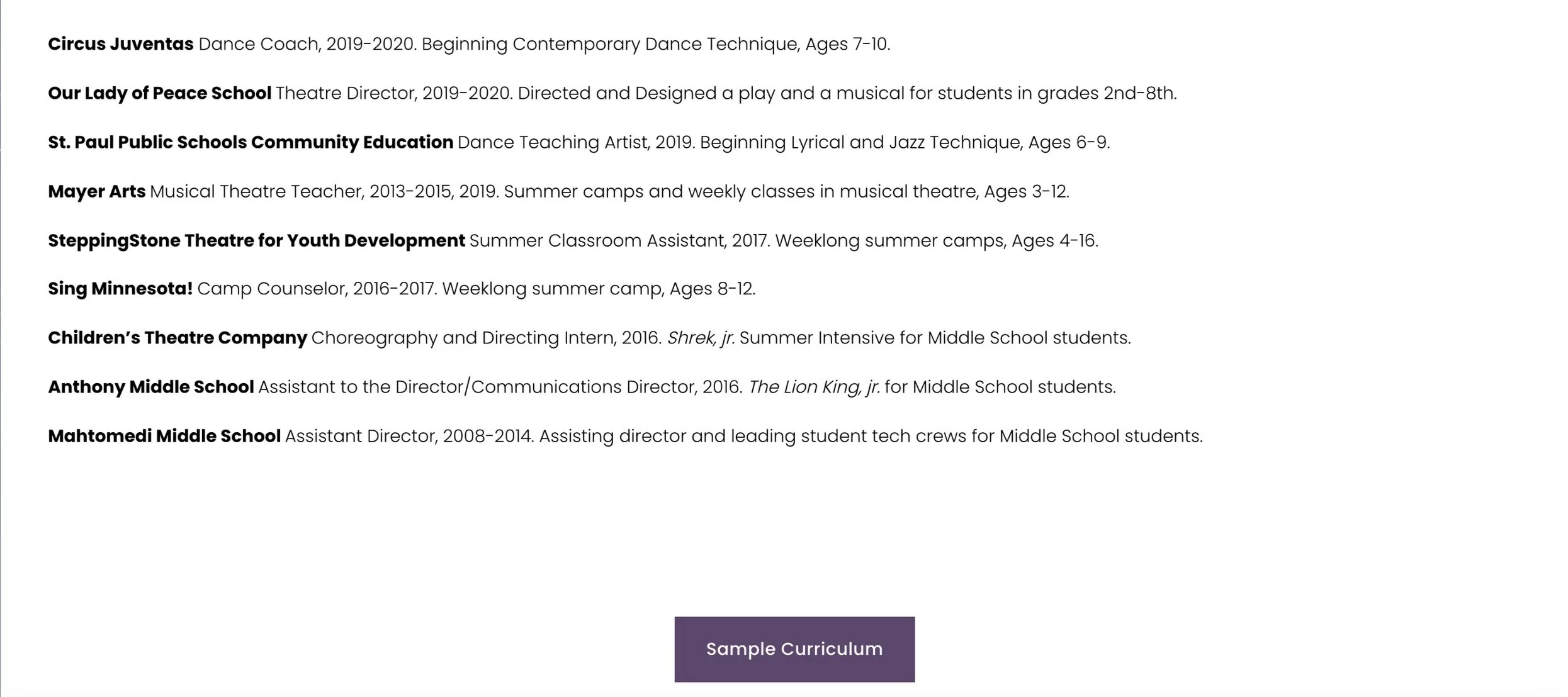
Principles of Teaching Artistry
Module 2, Part 6
The second half of Free Play brought to mind a recent conversation I had with a friend and retired theatre director about my experience as a 4th grade student when our class play was a production of Shakespeare’s Macbeth. I believe I may have written about this a bit before, but this recent conversation brought up a lot of questions about the experience. As I read Free Play I thought about how this experience nurtured my young creative brain and what it taught me, beyond sparking an interest in theatre. I want to reflect a bit on what the author wrote about the voice of the inner child and how that can be expressed or repressed as we grow. For me, it has done both (as I imagine is the case for many people). As a 4th grade student, I didn’t know any different: we were doing a class play and it was written by someone named Shakespeare who was apparently very important. Each 4th/5th grade classroom did a different play (The Tempest and A Midsummer Night’s Dream were the other selections). But as I look back at this time, I have so many questions. Why these plays? How were the very challenging topics of Macbeth addressed? I pulled out my script to see if there was anything that might help me remember this experience. There was no sugar-coating. There was death, mental illness, murder, blood, witches, and everything else you’d expect in Macbeth, only this version is shorter. It’s difficult to imagine what it would be like to introduce such deep topics to young students today.
On the other hand, perhaps this experience is the reason that I have felt comfortable with death and other “dark” topics. Discussions of death seem normal to me and always have. As I grew older, I experienced the deaths of several mentors and teachers, whom I cherished and grieved deeply for many years. I visited friends in the hospital while they were dying. When I was 17 I held my friend’s hand as she took her final breath. It was intense and meaningful, but I was not afraid. I’ve never really thought about where this feeling came from—this ease and sense of closeness to that liminal space between life and death. Of course, death can be horrifying and is tragic, and I have grieved deeply for people I love and people I barely know.
Perhaps it was Macbeth which showed me grief, pain, and real fear for the first time that taught me that dark or difficult topics don’t need to be hidden away. By removing them from sight and suppressing our feelings, we only make them darker and more powerful. The openness with which we could discuss them at such an early age perhaps instilled in me an understanding of what death and life can really mean. I would say that’s an important life lesson and worth trying to give to young people.
I’m going to reach out to my teacher who directed this production and see if she would speak with me about it. I would love to know how she experienced this play and directed it.
In connection with the above realizations, I think an important pedagogical aspiration for me is to introduce students to ideas and topics that may be new and even challenging (in a way that is safe and accessible to them of course). These are the moments I remember most as a student and what a privilege it would be to guide my students in similar important work.
As a teaching artist, I’m interested in working with all age groups. In an ideal world, I could teach both theatre and dance courses at a university and then supplement that by teaching adult dance classes on the weekends and/or teaching creative movement or other kids’ classes in the summer or weekends, along with pursuing my own dramaturgy or stage management career. Sounds a bit indecisive and complicated! But I have a belief that I will end up where I’m meant to be, I just don’t want to close off any avenues of interest just yet.
One of the most critical things I’m learning in this program is how to create art and teach it at the same time. Creating my own work (whether that be writing, choreographing, stage management, or other creative pursuits) enhances my ability to teach, but it also gives me great joy along with the frustration of creative work. My passion for creating seeps into my teaching and makes me a more interesting educator.
Thinking about who this is for, of course I hope it’s for the potential students I will teach, but it is also for me. It is for my personal development and simply the work of understanding myself as a person and an artist. This will make me more capable of teaching others.
Nachmanovitch, S. (1990). Free play: Improvisation in life and art. Tarcher/Putnam.
Module 2, Part 4
Resources:
https://www.theartistnextlevel.com/wp-content/uploads/2018/05/Business-Plan-for-Artists-Template-1.pdf
https://www.austintexas.gov/sites/default/files/files/Parks/Dougherty/artistresourcecenter/Creating%20an%20Artist%20Business%20Plan.pdf
Module 2, Part 3
In preparation for applying to the WSU MA-TA program, I spent a lot of time updating and refining my website. At that time, I considered the “Educator” section of the website was the weakest portion. Two specific factors contributed to this:
1. Lack of compelling images that are relevant to my actual interests (most pictures are not publishable online as they contain children’s faces. I was fortunate to have used masks in one of my classes, so I could include those).
2. Lack of teaching experience that can be communicated via website (which became evident when I reflected on what I’ve actually done so far).
3. Page format
The strongest parts of the page are: a printable teaching resume and a sample dance class curriculum.
I’ve now edited this page a bit to better reflect my experience and use some of the pictures that I used last semester in Artistic Praxis II. I’ve also added the current draft of my teaching artist manifesto. In addition, I’ve included the syllabus I created for a college-level dance course for Arts and Human Development. Finally, I rearranged the layout of the page to be more compelling and interesting.
In the future, I would like to add more elements from the MA-TA program, potentially including excerpts of my writing. I’m also not completely satisfied with the layout, but I think this version is stronger than the last. Compared to other pages on my website, this one still isn’t the strongest and most communicative of my experience, but I think this is much improved!
I would also like to create a video montage of teaching experience, which I began in Artistic Praxis II. Once I’ve done more teaching, I feel this would be something that could explain my teaching style and skills more effectively than written text.
As I reflect on the entirety of my website, I wonder how or if I should work to integrate some of my other experience into my Educator section. For example, I’ve done a lot of mentoring of students in stage management, but I’m not sure how to communicate that work. Perhaps I could incorporate this into my teaching artist manifesto statement.
Below are images of what the page looked like before this revision. Click here to see the revised page.
Module 2, Part 2
Teaching Artist Manifesto (January 30, 2022)
As a teaching artist, I feel called to share the joys and challenges of practicing art and creativity. I believe that arts education should be available to all and that participating in the arts enhances all aspects of life, regardless of skill level or experience.
With experience in and passion for both theatre and dance, I seek to give students broad experiences in performance, stage management, choreography, directing, dramaturgy, history, and arts administration.
In the five years since graduating with a BA in Theatre Arts with a Dance Minor, I have had the opportunity to teach and mentor students of all ages in a variety of settings—from community education classes to college theatre and dance programs. Pursuing my MA in Theatre and Dance has allowed me to reconnect with myself as a creative artist. In the years to come, I hope to continue to grow in my personal artistry and experiences.
I aspire to teach students of all ages, with a special focus towards college aged students preparing to enter the professional world as well as adults seeking continuing education. Though I was fortunate to begin my theatre education and work as a young person, I did not discover dance until much later. Because of that experience, I learned the value of teaching adult beginners and the great joy, excitement, and dedication that this community has for pursuing art.
In addition to teaching adults, I hope to become a professor at a college or university and teach a variety of theatre and dance courses which fit the interests and skills that I’ve developed, including: beginning level dance courses, theatre and dance history, and stage management.
I have always deeply admired my teachers and their dedication to my education. I aspire to help students feel important, challenged, and supported in their work.
Winter 2022 Check In
Hello All! I’m excited to begin another semester working together. I am grateful for the connections we’ve made throughout the past few semesters and hope that those connections will deepen as we go forward. I’m enjoying this program and feel it is pushing me in new directions and approaches to learning.
As some of you may know, I care for a 95-year-old friend and live in the apartment above his home. This responsibility has made the pandemic particularly stressful, but thankfully we’ve been very lucky to avoid illness thus far.
In addition to my graduate work, I’m taking an in person Tap Technique class this semester at the university where I completed my undergrad. I’m also working as the production coordinator for their annual dance concert, Spring Into Dance, which will celebrate its 10th anniversary this year! I’m thrilled, as this is something I participated in for several years before the pandemic and I was not expecting to be able to come back to it this year. In addition to my role as production coordinator and assistant to the director, I will be choreographing the piece that was part of my Artistic Praxis project last semester. I’m excited to continue working on it and to have it performed as part of this concert.
In terms of documenting work and ideas, I often use the notes app in my phone to record random thoughts, choreography ideas, music, etc. because my phone is almost always with me. I try to keep things relatively organized so that I can find these things easily when I want to refer to them. I also enjoy journaling and writing in a notebook when I have time.
As for digital space, I’ve used my personal/professional website on SquareSpace to create a place for all of my coursework (I use pages that are not linked to my public pages, so they can’t be found unless given the specific link). I have found this works well and keeps everything in one place on my website.
I’m currently planning to write a thesis on the topic of the history, technique, and pedagogy of the Humphrey-Limón and how it has been passed from teacher to student. I’m not opposed to switching to an essay, but I’d like to try to complete the thesis if I can. I’m completing my first Directed Study course this semester, so I anticipate I will begin working on steps toward my thesis in earnest this semester! I recently started using an app called Zotero to organize my sources, which seems useful. I’ve never worked with this app before, so I’m still learning about it, and if anyone has suggestions or tips, I’d love to hear them. The part of this work that feels a little overwhelming is the amount of reading I will need to do to write the thesis and the idea of keeping track of notes from so many sources. Again, I welcome any suggestions or help with organizing this process.
I’m really looking forward to another semester with everyone!

